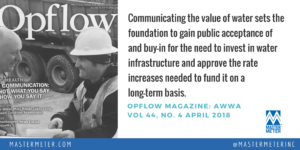Water is life. It’s a catchy slogan that is so true we often miss the forest for the trees. Water is, quite literally, life. Without it, life as we know it ceases to exist. And yet modern day water treatment and distribution infrastructure and operational systems have made the gift of water so easy, we’ve forgotten the simple magic behind those precious drops that readily flow from our faucets. The waste we produce disappears down a drain or a toilet and we wash our hands of the rest of its journey. How do we communicate the true value of water? What story do we tell?
May 14-21, 2018 marks Infrastructure Week, a national week of education and advocacy that brings together American businesses, workers, elected leaders, and everyday citizens around one message. The rallying cry this year is: The future won’t wait. Neither can we. It’s #TimeToBuild. It shines a spotlight on all infrastructure including roads, bridges, rail, ports, airports, water and sewer systems, the energy grid, telecommunication, and more.
Most of that infrastructure exists above ground. It’s easier to see, inspect, and maintain the slow decay of visible infrastructure. When it’s buried deep beneath the ground, it gets a little trickier. It often falls out of sight, out of mind.
How then do we keep the value of our water and sewer infrastructure in the conversation?
Awareness weeks like the non-profit led Infrastructure Week is one way. It’s an opportunity to engage with stakeholders, policy makers and citizens using events and both digital media and traditional media strategies. However, we can’t only rely on annual awareness efforts. The water industry needs to communicate this message consistently and frequently,
Recent estimates state that $4.8 trillion needs to be invested in water infrastructure over the next twenty years to maintain a state of good repair, according to the American Society of Engineers. (http://thevalueofwater.org/)
In America today, a water main breaks every 2 minutes. Water utilities can use repair and maintenance as opportunities to engage the public about the challenges related to aging infrastructure.

Feeling overwhelmed? Not sure where to start. You have the support of the entire water industry behind you. This message is permeating water conference sessions, keynotes, webinars, publications and industry journals.
An entire afternoon was dedicated to the value of water at the 2018 Texas Water conference, the largest regional water conference in the United States. According to the Texas Water website, the value of water tract is designed to foster networking and dialogue amongst water and wastewater utilities of all sizes focusing on the common outreach component of a project or challenges experienced with responding, interacting or communicating to end users.
There are over 30 leaders from various sectors of the water industry connected to the Value of Water Campaign’s Imagine a Day Without Water–a national day of awareness. The primary focus of this single day in October is to communicate the value of water.
Funding requests without any effort to educate customers is essentially like handing customers a book with the opening chapters ripped out. Communicating the value of water from the customer’s perspective is where the story begins. People have to know why you care. They need to know how it impacts them in order for the information to resonate and garner public support.
According to the 2018 April edition of AWWA’s Opfow Magazine, communicating the value of water sets the foundation to gain public acceptance of and buy-in for the need to invest in water infrastructure and approve the rate increases needed to fund it on a long-term basis.
Technology and social media create an environment where misinformation has the ability to spread rapidly. Sometimes the issue isn’t even misinformation, but correct information that customers have no context with. When people aren’t given the full story, their mind fills in the gaps with whatever personal experience has available. If their only context are news stories like Flint, MI and your latest boil notice, you can imagine how those gaps will be interpreted. The world of water post-Flint is a new animal. It’s the responsibility of our industry and its members to step into the spotlight, answer the hard questions and build trust and advocates in our communities.

